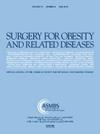Conversion of sleeve gastrectomy to Roux-en-Y laparoscopic gastric bypass: a comprehensive 14-year follow-up study on efficacy and outcomes
IF 3.5
3区 医学
Q1 SURGERY
引用次数: 0
Abstract
Background
Failed sleeve gastrectomy (SG), defined by inadequate weight loss or weight regain and by reflux and structural complications, can be treated by a laparoscopic conversion to Roux-en-Y gastric bypass (RYGB).
Objectives
To examine the efficacy and outcomes of conversion surgery over a 14-year follow-up period.
Setting
Government and private medical centers in university settings.
Methods
We conducted a cohort study of 58 patients who underwent conversion of SG to RYGB for 2 indications: invalidating reflux or weight recurrence during 2009–2023. Weight dynamics analysis was performed with 2 references of weight: before SG (with intention to treat) and before conversion.
Results
At conversion surgery, the mean weight, body mass index (BMI), percentage of excess weight loss (%EWL), and percentage of total weight loss (%TWL) (calculated with intention to treat, from the weight before SG) were 92.2 ± 25.2 kg, 34.3 ± 8.0 kg/m2, 55.2% ± 39.9%, and 22.8% ± 15.2%, respectively. Mean nadir weight, BMI, %EWL, and %TWL after conversion (calculated from the weight before SG) were 71.1 ± 18.4 kg, 26.7 ± 5.5 kg/m2, 96.5% ± 30.5%, and 40.2% ± 10.6%, respectively. At follow-up, the mean weight, BMI, %EWL, and %TWL (calculated from the weight before SG) were 80.4 ± 17.7 kg, 29.6 ± 5.4 kg/m2, 78.9% ± 26.8%, and 33.3% ± 11.2%, respectively. The mean percentages of %EWLio and %TWLio (calculated from the weight before conversion = EWL from index operation) at nadir were 73.2% ± 92.7% and 20.1% ± 12.2% after conversion, respectively, and decreased to 41.9% ± 94.0% and 13.2% ± 15.2% at last follow-up (mean 6.6 yr), respectively.
Conclusions
SG to RYGB conversion provides moderate to low complementary weight loss in the short term. By 3–4 years, there is a clear trend toward weight gain.
袖带胃切除术转为 Roux-en-Y 腹腔镜胃旁路术:关于疗效和结果的 14 年综合随访研究
袖带胃切除术(SG)失败的定义是体重减轻不足或体重反弹以及反流和结构性并发症,可以通过腹腔镜转换为 Roux-en-Y 胃旁路术(RYGB)来治疗。在长达14年的随访期间,研究转换手术的疗效和结果。研究对象为大学环境中的公立和私立医疗中心。我们对 2009-2023 年间因反流失效或体重复发这两种适应症而接受 SG 转 RYGB 手术的 58 名患者进行了队列研究。体重动态分析以两种体重为参考:SG 前(意向治疗)和转换前。转换手术时,平均体重、体重指数(BMI)、超重百分比(%EWL)和总减重百分比(%TWL)(根据手术前的体重,按治疗意向计算)分别为 92.2 ± 25.2 千克、34.3 ± 8.0 千克/米、55.2% ± 39.9% 和 22.8% ± 15.2%。转换后的平均基准体重、BMI、%EWL 和 %TWL(根据 SG 前的体重计算)分别为 71.1 ± 18.4 千克、26.7 ± 5.5 千克/米、96.5% ± 30.5%和 40.2% ± 10.6%。随访时,平均体重、BMI、%EWL 和 %TWL(根据 SG 前的体重计算)分别为 80.4 ± 17.7 千克、29.6 ± 5.4 千克/米、78.9% ± 26.8%和 33.3% ± 11.2%。转换后,最低点时的平均百分比%EWLio和%TWLio(根据转换前体重=指数手术时的EWL计算)分别为73.2%±92.7%和20.1%±12.2%,最后一次随访(平均6.6年)时分别降至41.9%±94.0%和13.2%±15.2%。从 SG 到 RYGB 的转换在短期内可提供中度到低度的补充性体重减轻。3-4 年后,体重增加趋势明显。
本文章由计算机程序翻译,如有差异,请以英文原文为准。
求助全文
约1分钟内获得全文
求助全文
来源期刊
CiteScore
6.70
自引率
12.90%
发文量
570
审稿时长
56 days
期刊介绍:
Surgery for Obesity and Related Diseases (SOARD), The Official Journal of the American Society for Metabolic and Bariatric Surgery (ASMBS) and the Brazilian Society for Bariatric Surgery, is an international journal devoted to the publication of peer-reviewed manuscripts of the highest quality with objective data regarding techniques for the treatment of severe obesity. Articles document the effects of surgically induced weight loss on obesity physiological, psychiatric and social co-morbidities.

 求助内容:
求助内容: 应助结果提醒方式:
应助结果提醒方式:


